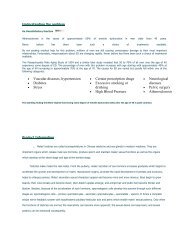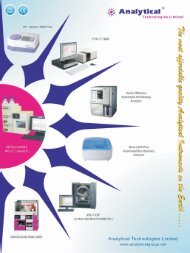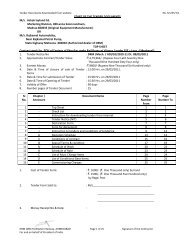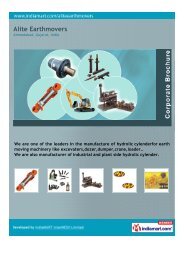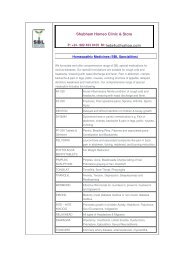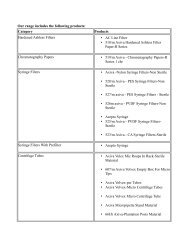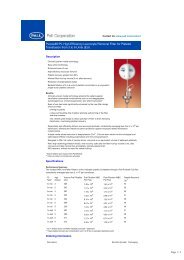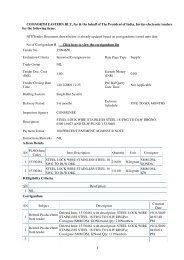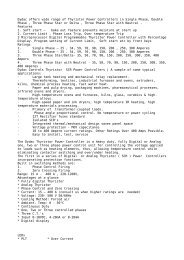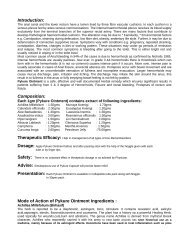AdhesSIL Silicone Rubber Cross Linker ( information is ... - Imimg
AdhesSIL Silicone Rubber Cross Linker ( information is ... - Imimg
AdhesSIL Silicone Rubber Cross Linker ( information is ... - Imimg
Create successful ePaper yourself
Turn your PDF publications into a flip-book with our unique Google optimized e-Paper software.
prints & graphics<br />
Page No.: 1/6<br />
Last Rev<strong>is</strong>ion Date: 13.06.2009<br />
Version: 1.0<br />
AdheSIL <strong>Silicone</strong> <strong>Rubber</strong> <strong>Cross</strong> <strong>Linker</strong><br />
Material Safety Data Sheet<br />
<strong>AdhesSIL</strong> <strong>Silicone</strong> <strong>Rubber</strong> <strong>Cross</strong> <strong>Linker</strong> ( <strong>information</strong> <strong>is</strong> below)<br />
1. IDENTIFICATION OF THE PRODUCT AND OF THE COMPANY<br />
1.1 Product Name:<br />
1.2 Manufacturer's Product Code:<br />
1.3 Chemical Classification:<br />
1.4 Use:<br />
1.5 Company Details<br />
Manufacturer/Supplier:<br />
Address:<br />
Telephone Number:<br />
Fax Number:<br />
Emergency Telephone<br />
Number:<br />
Contact Person:<br />
AdheSIL Sililcone <strong>Rubber</strong> Base<br />
02360128<br />
Liquid <strong>Silicone</strong> <strong>Rubber</strong><br />
<strong>Silicone</strong> rubber <strong>Cross</strong> <strong>Linker</strong><br />
G prints & graphics<br />
Pandit guruji margh, Shahapur D<strong>is</strong>t: Thane, Maharashtra, INDIA<br />
02527 272626<br />
02527 272626<br />
09422092907<br />
Environment, Health and Safety Leader<br />
2. COMPOSITION / INFORMATION ON INGREDIENTS<br />
2.1 Chemical characterization: Mixture<br />
2.2 Hazardous Ingredients:<br />
Chemical Name CAS No. % (w/w) Symbols & Health R<strong>is</strong>k Phrases<br />
Ethynyl cyclohexanol 78-27-3
prints & graphics<br />
Page No.: 2/6<br />
Last Rev<strong>is</strong>ion Date: 13.06.2009<br />
Version: 1.0<br />
AdheSIL <strong>Silicone</strong> <strong>Rubber</strong> <strong>Cross</strong> <strong>Linker</strong><br />
Material Safety Data Sheet<br />
<strong>AdhesSIL</strong> <strong>Silicone</strong> <strong>Rubber</strong> <strong>Cross</strong> <strong>Linker</strong> ( <strong>information</strong> <strong>is</strong> below)<br />
4.6 Note to physicians: Treat symptomatically. For further <strong>information</strong>, the medical practitioner should<br />
contact G prints & graphics.<br />
5. FIRE-FIGHTING MEASURES<br />
5.1 Hazardous Properties: None.<br />
5.2 Extingu<strong>is</strong>hing Media: On large fires use AFFF alcohol compatible foam or water spray (fog). On small<br />
fires use AFFF alcohol compatible foam, CO2 or water spray (fog). Water can be<br />
used to cool fire exposed containers. Most fire extingu<strong>is</strong>hing media will cause<br />
hydrogen evolution. When the fire <strong>is</strong> put out, hydrogen may accumulate in poorly<br />
ventilated or confined areas and result in flash fire or explosion if ignited. Foam<br />
blankets may also trap hydrogen or flammable vapors, with the possibility of<br />
subsurface explosion.<br />
5.3 Special Fire Fighting<br />
Procedures and<br />
Equipment:<br />
5.4 Hazardous Combustion<br />
Products:<br />
5.5 Unsuitable<br />
Extingu<strong>is</strong>hing Media:<br />
Self-contained breathing apparatus and protective clothing should be worn in<br />
fighting large fires involving chemicals. Determine the need to evacuate or <strong>is</strong>olate<br />
the area according to your local emergency plan. Use water spray to keep fire<br />
exposed containers cool.<br />
Carbon oxides and traces of incompletely burned carbon compounds. Silicon<br />
dioxide. Formaldehyde. Hydrogen.<br />
Dry powder. Do not allow extingu<strong>is</strong>hing medium to contact container contents.<br />
6. ACCIDENTAL RELEASE MEASURES<br />
6.1 Personal Precautions: Avoid eye contact. Do not take internally.<br />
6.2 Environmental<br />
Precautions:<br />
Prevent from spreading or entering into drains, ditches or rivers by using sand,<br />
earth or other appropriate barriers.<br />
6.3 Methods for Cleaning<br />
up:<br />
Determine whether to evacuate or <strong>is</strong>olate the area according to your local<br />
emergency plan. Observe all personal protective equipment recommendations<br />
described in th<strong>is</strong> MSDS. If diked material can be pumped, store recovered material<br />
in appropriate container. Materials in contact with water, mo<strong>is</strong>ture, acids or bases<br />
have the potential to generate hydrogen gas. Recovered material should be stored<br />
in a vented container. Clean up remaining materials from spill with suitable<br />
absorbant. Clean area as appropriate since spilled materials, even in small<br />
quantities, may present a slip hazard. Final cleaning may require use of steam,<br />
solvents or detergents. D<strong>is</strong>pose of saturated absorbant or cleaning materials<br />
appropriately, since spontaneous heating may occur. Laws and regulations may<br />
apply to releases and d<strong>is</strong>posal of th<strong>is</strong> material, as well as those materials and items<br />
employed in the cleanup of releases. You will need to determine which laws and<br />
regulations are applicable.<br />
7. HANDLING AND STORAGE<br />
7.1 Handling Precautions: Use with adequate ventilation. Avoid eye contact. Do not take internally. Exerc<strong>is</strong>e<br />
good industrial hygiene practice. Wash after handling, especially before eating,<br />
drinking or smoking.
prints & graphics<br />
Page No.: 3/6<br />
Last Rev<strong>is</strong>ion Date: 13.06.2009<br />
Version: 1.0<br />
AdheSIL <strong>Silicone</strong> <strong>Rubber</strong> <strong>Cross</strong> <strong>Linker</strong><br />
Material Safety Data Sheet<br />
<strong>AdhesSIL</strong> <strong>Silicone</strong> <strong>Rubber</strong> <strong>Cross</strong> <strong>Linker</strong> ( <strong>information</strong> <strong>is</strong> below)<br />
7.2 Storage Conditions: Product evolves minute quantities of flammable hydrogen gas which can<br />
accumulate. Adequately ventilate to maintain vapors well below flammability limits<br />
and exposure guidelines. Do not repackage. Do not store in glass containers<br />
which may shatter due to pressure build up. Clogged container vents may increase<br />
pressure build up. Keep container closed and store away from water or mo<strong>is</strong>ture.<br />
7.3 Unsuitable Packaging<br />
Materials:<br />
Do not store in or use glass containers.<br />
8. EXPOSURE CONTROLS/PERSONAL PROTECTION<br />
8.1 Industrial Hygiene Standards<br />
Ingredients CAS No. Exposure Limits<br />
Ethynyl cyclohexanol 78-27-3 Observe particulate limits. OSHA PEL: TWA 15 mg/m3 total<br />
dust, 5 mg/m3 respirable fraction. ACGIH TLV: TWA 10<br />
mg/m3 inhalable particulate, 3 mg/m3 respirable particulate.<br />
8.2 Engineering Controls<br />
Local Ventilation: Recommended.<br />
General Ventilation: Recommended.<br />
8.3 Personal Protective Equipment for Routine Handling<br />
Respiratory protection: No respiratory protection should be needed.<br />
Suitable Respirator: None should be needed.<br />
Eye:<br />
Use proper protection - safety glasses as a minimum.<br />
Hand:<br />
No special protection needed.<br />
Skin:<br />
Washing at mealtime and end of shift <strong>is</strong> adequate.<br />
Personal Hygiene: Exerc<strong>is</strong>e good industrial hygiene practice. Wash after handling, especially before<br />
eating, drinking or smoking.<br />
8.4 Personal Protective Equipment for Spills<br />
Respiratory protection: No respiratory protection should be needed.<br />
Eye protection:<br />
Use proper protection - safety glasses as a minimum.<br />
Skin protection: Washing at mealtime and end of shift <strong>is</strong> adequate.<br />
9. PHYSICAL AND CHEMICAL PROPERTIES<br />
9.1 Physical Form: V<strong>is</strong>cous Liquid<br />
9.2 Color: Colorless<br />
9.3 Odor: Slight odor<br />
9.4 pH: Not determined.<br />
9.5 Solubility in Water: Not determined.<br />
9.6 Boiling Point: > 100 °C<br />
9.7 Melting Point: Not determined.<br />
9.8 Flash Point: > 100 °C (Closed Cup)<br />
9.9 Autoignition<br />
Not determined.<br />
Temperature:<br />
9.10 Explosive properties: No
prints & graphics<br />
Page No.: 4/6<br />
Last Rev<strong>is</strong>ion Date: 13.06.2009<br />
Version: 1.0<br />
AdheSIL <strong>Silicone</strong> <strong>Rubber</strong> <strong>Cross</strong> <strong>Linker</strong><br />
Material Safety Data Sheet<br />
<strong>AdhesSIL</strong> <strong>Silicone</strong> <strong>Rubber</strong> <strong>Cross</strong> <strong>Linker</strong> ( <strong>information</strong> <strong>is</strong> below)<br />
9.11 Oxidizing properties: No<br />
9.12 Vapor Pressure @ 25°C: Not determined.<br />
9.13 Specific Gravity: 1.2<br />
9.14 Octanol/water partition Not determined.<br />
coefficient:<br />
9.15 Vapour Density (air=1): Not determined.<br />
9.16 V<strong>is</strong>cosity: 2000 cSt<br />
9.17 Upper Flammability<br />
Limit:<br />
9.18 Lower Flammability<br />
Limit:<br />
Not determined.<br />
Not determined.<br />
10. STABILITY AND REACTIVITY<br />
10.1 Stability: Stable under normal usage conditions. Material may decompose (generating heat<br />
and gas) if exposed to temperatures in excess of 250 degree C.<br />
10.2 Reactivity<br />
Conditions to Avoid:<br />
Materials to Avoid:<br />
Hazardous<br />
Decomposition<br />
Products:<br />
Hazardous<br />
Polymerization:<br />
None.<br />
Water, alcohols, acidic or basic materials, and many metals or metallic compounds,<br />
when in contact with product, liberate flammable hydrogen gas, which can form<br />
explosive mixtures in air. Can react with strong oxid<strong>is</strong>ing agents.<br />
Carbon oxides and traces of incompletely burned carbon compounds. Silicon<br />
dioxide. Formaldehyde. Hydrogen.<br />
Hazardous polymerization will not occur.<br />
11. TOXICOLOGICAL INFORMATION<br />
11.1 Routes of Entry<br />
[ X] Inhalation [X] Skin Contact [X] Ingestion<br />
11.2 Possible Health Effec ts<br />
Acute<br />
Skin:<br />
Eye:<br />
Inhalation:<br />
Ingestion:<br />
Chronic<br />
Skin:<br />
Inhalation:<br />
Ingestion:<br />
No significant irritation expected from a single short-term exposure.<br />
Direct contact may cause mild irritation.<br />
No significant effects expected from a single short-term exposure.<br />
Low ingestion hazard in normal use.<br />
Repeated or prolonged exposure may cause irritation.<br />
No known applicable <strong>information</strong>.<br />
Repeated ingestion or swallowing large amounts may injure internally.<br />
11.3 Sensitizing Effects: None known.<br />
11.4 Mutagenic Effects: None known.<br />
11.5 Reproductive Effects: None known.<br />
11.6 Carcinogenic Effects: None known.
prints & graphics<br />
Page No.: 6/6<br />
Last Rev<strong>is</strong>ion Date: 13.06.2009<br />
Version: 1.0<br />
AdheSIL <strong>Silicone</strong> <strong>Rubber</strong> <strong>Cross</strong> <strong>Linker</strong><br />
Material Safety Data Sheet<br />
<strong>AdhesSIL</strong> <strong>Silicone</strong> <strong>Rubber</strong> <strong>Cross</strong> <strong>Linker</strong> ( <strong>information</strong> <strong>is</strong> below)<br />
AICS<br />
DSL<br />
IECSC<br />
EINECS<br />
KECL<br />
PICCS<br />
TSCA<br />
: All ingredients l<strong>is</strong>ted or exempt.<br />
: All chemical substances in th<strong>is</strong> material are included on or exempted from the<br />
DSL.<br />
: All ingredients l<strong>is</strong>ted or exempt.<br />
: All ingredients l<strong>is</strong>ted or exempt.<br />
: All ingredients l<strong>is</strong>ted, exempt or notified.<br />
: All ingredients l<strong>is</strong>ted or exempt.<br />
: All chemical substances in th<strong>is</strong> material are included on or exempted from l<strong>is</strong>ting<br />
on the TSCA Inventory of Chemical Substances.<br />
16. OTHER INFORMATION<br />
Contact Point:<br />
Prepared by:<br />
Environment, Health and Safety Leader<br />
G prints & graphics<br />
Th<strong>is</strong> <strong>information</strong> <strong>is</strong> offered in good faith as typical values and not as a product specification. No warranty, expressed or<br />
implied, <strong>is</strong> hereby made. The recommended industrial hygiene and safe handling procedures are believed to be<br />
generally applicable. However, each user should review these recommendations in the specific context of the intended<br />
use and determine whether they are appropriate.
prints & graphics<br />
Page No.: 6/6<br />
Last Rev<strong>is</strong>ion Date: 13.06.2009<br />
Version: 1.0<br />
AdheSIL <strong>Silicone</strong> <strong>Rubber</strong> <strong>Cross</strong> <strong>Linker</strong><br />
Material Safety Data Sheet<br />
<strong>AdhesSIL</strong> <strong>Silicone</strong> <strong>Rubber</strong> <strong>Cross</strong> <strong>Linker</strong> ( <strong>information</strong> <strong>is</strong> below)<br />
11.7 Other Health Hazard<br />
Information:<br />
No known applicable <strong>information</strong>.<br />
The above l<strong>is</strong>ted potential effects of overexposure are based on actual data, the results of studies performed upon similar<br />
compositions, component data, and/or expert review of the products.<br />
12. ECOLOGICAL INFORMATION<br />
12.1 Environmental Fate and D<strong>is</strong>tribution<br />
Siloxanes are removed from water by sedimentation or binding to sewage sludge. In soil, siloxanes are<br />
degraded.<br />
12.2 Ecotoxicity: No adverse effects on aquatic organ<strong>is</strong>ms.<br />
Bioaccumulation:<br />
12.3 Fate and Effects in<br />
Waste Water Treatment<br />
Plants:<br />
No bioaccumulation potential.<br />
Removed > 90% by binding onto sewage sludge. No adverse effects on bacteria.<br />
The siloxanes in th<strong>is</strong> product do not contribute to the BOD.<br />
12.4 Additional Environmental Information<br />
Degradation:<br />
Additional environmental <strong>information</strong> on the silicone component <strong>is</strong> available on<br />
request.<br />
13. DISPOSAL INFORMATION<br />
13.1 Product D<strong>is</strong>posal: D<strong>is</strong>pose of in accordance with local regulations.<br />
13.2 Packaging D<strong>is</strong>posal: D<strong>is</strong>pose of in accordance with local regulations.<br />
14. TRANSPORT INFORMATION<br />
14.1 Road and Rail Transport<br />
Not applicable.<br />
14.2 Sea transport (IMDG)<br />
Not subject to IMDG code.<br />
14.3 Air Transport (IATA)<br />
Not subject to IATA regulations.<br />
Remarks:<br />
VENTED PACKAGES ARE FORBIDDEN FOR AIR TRANSPORT.<br />
15. REGULATORY INFORMATION<br />
15.1 NFPA Hazard Signals<br />
Health 1 Flammability 1 Instability 1 Special -<br />
15.2 Chemical Inventories<br />
ENCS/ISHL<br />
: All components are l<strong>is</strong>ted on ENCS/ISHL or its exempt rule.


